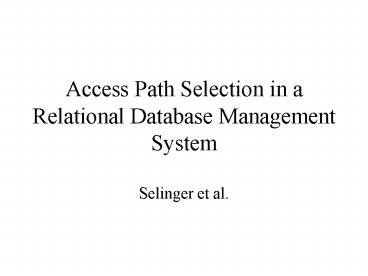Access Path Selection in a Relational Database Management System - PowerPoint PPT Presentation
1 / 19
Title:
Access Path Selection in a Relational Database Management System
Description:
Estimation of input and intermediate cardinalities based on simple ... When no estimate available, use magic number. These estimations are done periodically ... – PowerPoint PPT presentation
Number of Views:370
Avg rating:3.0/5.0
Title: Access Path Selection in a Relational Database Management System
1
Access Path Selection in a Relational Database
Management System
- Selinger et al.
2
Query Optimization
- Declarative query language relieves programmer of
the burden to choose an access plan. - Difference between good and bad access plans can
be several orders of magnitude. - Problem How do we find a good plan?
3
How to choose a good plan?
- Divide into three problems
- What is the set of plans we consider?
- How do we compare (cost) plans?
- How do we choose a good plan from this set?
4
Background SQL
- SELECT DISTINCT ltlist of columnsgt
- FROM ltlist of tablesgt
- WHERE ltlist of "Boolean Factors(predicates in
CNF)gt - GROUP BY ltlist of columnsgt
- HAVING ltlist of Boolean Factorsgt
- ORDER BY ltlist of columnsgt
5
Processing SQL Statements
- Four steps
- Parsing
- Optimization
- Code generation
- Execution
6
SQL Query Types
- Single block queries only
- optimize nested sub-queries separately
- Correlated sub-queries are much harder and much
more expensive than un-correlated sub-queries. - Rewrite to remove correlations where possible.
(Tricky, more about this later.) - SPJ queries only in this paper
7
Problem 1 Plan Space
- Fixed set of individual access methods
- Sequential index (clustered/unclustered) scans
- NL-join, (sort)-merge join, hash join
- Sorting hash-based grouping
- Plan flows in a non-blocking fashion with
get-next iterators
8
Plan Space (Contd.)
- Assumptions in System R
- Selections of sargable predicates are "pushed
down" - Projections are "pushed down"
- Single query blocks
- Only left-deep plan trees (There are n! plans
(not factoring in choice of join method)) - Avoid Cartesian products
9
Problem 2 How to Cost a Plan
- Estimation of input and intermediate
cardinalities based on simple statistical models
(e.g., uniform distribution assumption, attribute
independence) - Estimation of costs for each operator based on
statistics about input relations - Cost is weighted function between I/O and CPU(no
distinction between random and sequential IO)
10
Cost Estimation (Selinger)
- Maintenance of simple statistics
- of tuples pages
- of values per column (only for indexed columns)
- Assumption of attribute independence
- When no estimate available, use magic number
- These estimations are done periodically
11
Cost Estimation (Today)
- Sampling so far only concrete results for base
relations - Histograms getting better. Common in industry,
some interesting new research. - Controlling "error propagation"
12
Problem 3 Choosing a Plan
- Exhaustive search
- Dynamic Programming (prunes suboptimal parts of
the search space) System R - Top-down, transformative version of DP Volcano,
Cascades (used in MS SQL Server?) - Randomized search algorithms (e.g. Ioannidis
Kang) - Techniques from Operations Research
- Etc.
13
System R Approach
- Recall Only left-deep plan trees (n! different
plans) - Observation Many of these plans share common
prefixes, so do not recompute all of them
Dynamic Programming
14
Dynamic Programming Approach
- Find all 1-table plans for each base relation
- Try all ways of joining i-table plans saved so
far with 1-table plans. Save cheapest unordered
(i1)-table plans, and cheapest (i1)-table plans
for each interesting order - Note secondary join predicates are just like
selections that cant be pushed down - At the end, GROUP BY and ORDER BY
- Use plan in interesting order, or add sort to
cheapest unordered plan.
15
Evaluation
- Complexity of dynamic programming about n2n-1,
intermediate storage plans - No-cartesian-products rule can make a big
difference for some queries. - DP only works up to 10-15 joins
- Adding parameters to the search space makes
things worse (e.g. expensive predicates,
distribution, parallelism, etc.)
16
Nested Queries
- Subqueries optimized separately
- Uncorrelated vs. correlated subqueries
- Uncorrelated subqueries are basically constants
to be computed once - Correlated subqueries are like function calls
17
Query Rewrite in IBM DB2
- Leung et al.
18
Why Query Rewrite?
- Problem
- Very complex queries automatically generated
through tools with many levels of subqueries - Correlated subqueries
- Selinger approach only works one block at a time
- Main idea Transform the query into a simpler,
equivalent query
19
Query Rewrite is Tricky
- SELECT P.pno
- FROM Parts P
- WHERE P.quantity
- (SELECT COUNT()
- FROM Supply S
- WHERE S.pno P.pno AND
- S.shipdate lt 1-1-2000)
- INSERT INTO Temp (pnum, cnt)
- (SELECT P.pno, COUNT()
- FROM Supply S
- WHERE S.shipdate lt 1-1-2000 GROUP BY P.pno)
- SELECT P.pno
- FROM Parts P, Temp T
- WHERE P.quantity T.cnt AND
- P.pno T.pno































